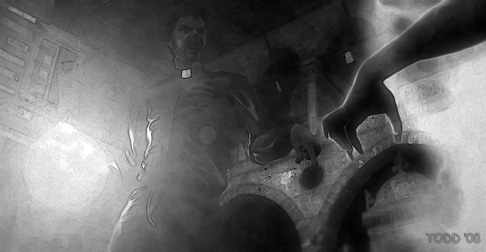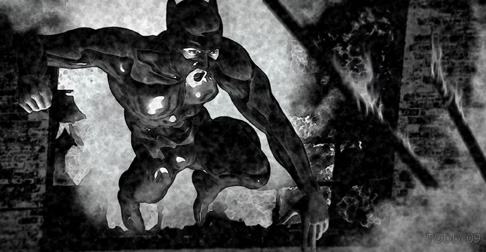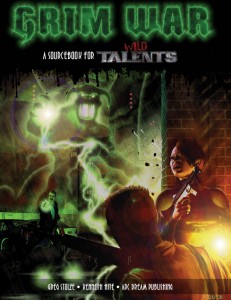As manager of Arc Dream Publishing I have the privilege of working with a lot of really good games. To be honest, that’s pretty much the whole reason Arc Dream exists. My partner Dennis Detwiller and I love roleplaying games; we particularly love a very specific style of roleplaying games; and we want more of those games to exist.
It can be hard to define exactly what that style is, but it usually has a lot to do with a detailed and heavily-researched approach to history, secrets that people die or kill to protect, a sense that power always comes with consequences, and action that is fast, bloody and suspenseful. It doesn’t hurt if Greg Stolze and Kenneth Hite are the authors, or if I can get Todd Shearer to provide illustrations.
Then there’s Grim War, a Wild Talents setting book by Greg Stolze and Kenneth Hite, with art by Todd Shearer.
It’s a world with secretive cabals of magicians who summon inhuman powers from beyond our reality, and very public groups of superpowered mutants whose abilities are as dangerous as they are amazing.
Boy, is it fun.
If you know what Greg Stolze and John Tynes did in Unknown Armies, and what Greg Stolze, Ken Hite, Dennis and I did in Wild Talents, then you’re a fair step toward grasping what Grim War is all about.
But let’s take a look at the book’s introduction by Greg Stolze, just to make sure.
History, Part One: The magicians have always been around.
Whether it was the pythian oracle, the witch of Endor, bone-pointing Aboriginal killers or voodoo-active pirates, there have always been people around who could call upon the supernatural and have it answer. There are varieties (spirit-binders, fetish-makers, animist shamans) but most forms of magic have long pedigrees.

They stayed hidden for a long time, mostly because the typical reaction of people without magic is quite violent when confronted with people who do have magic. There are all kinds of crazy stories about the Borgia popes being satanic magicians, about Pilgrim warlocks using magic to clean out the natives before being unmasked at the Salem trials, about the efficacy of human sacrifice in Central America going head-to-head with the angelic protectors of Catholic conquistadors. It’s hard to say anything for sure before the Theosophists came out into the open and Spiritualist Movement surged after World War I. But there were just enough people eager for some kind of light after the war’s darkness, hoping for contact with the Other Side and reassurance that mankind was being guided to a better place. Lots of people pursued Spiritualism, and a few things got scientifically verified.
Magic worked. It could contact dead people and provide information that indisputably demonstrated the existence of some kind of human memory after the death of the physical body.
Magic could also contact immaterial intelligences that were not and had never been human.
Not everyone could do it. Two “operators” of equal education could perform the exact same rites, with only one succeeding. Common wisdom holds that some immaterial force of will is necessary to infuse the form of a spell with the energy to operate. Only those with powerful personalities seem to become magicians.
Among those who can do magic at all, the simplest sort seems to be subtle influence on the physical world.
Gross distortions of the physical world aren’t nearly as common or easy. But they aren’t impossible.
The vogue for magic lasted until a few scrappy investigators discovered that, far from being a new cultural force, there had been magicians quietly influencing politics for as long as fifty years. The calumny that magicians caused the Great War is certainly a gross oversimplification, but most people believe that there were magicians who encouraged it and spirits that greatly enjoyed or benefitted from it. As you might guess, the spirits who got off on trench warfare are not the most pleasant kind.
But magic didn’t really earn the fear and hatred of the common man until the rise of National Socialism in Germany. Based around a cabal of enchanters, the Nazis were the first openly sorcerous government. Their atrocities are now considered the primary example of what magicians do when given authority.
After World War II, the practice of ritual magic was banned in most countries, and much of the lore was lost or suppressed. While both the U.S. and USSR legally repressed the practice (after the Supreme Court decided, in The People vs. Megan Boroviak, that magic acts were separate from religion and were therefore exempt from Constitutional protection), it’s long been suspected that both sides were secretly using enchantment in their games of espionage, brinksmanship and battles through proxy nations. Indeed, a few dramatic screwups on both sides revealed to all but the most blindly patriotic that most nations were attempting, desperately in some cases, to acquire or recreate lost occult knowledge. A play on one of the words for a magical tome is one reason that the long period of covert strife between Russia and America is called the Grim Wars.
Despite the rhetoric of People for Religious Liberation (a so-called “magicians-rights” movement) that “once you outlaw magic, only outlaws will use magic,” most people abhor sorcery. Of course, laws and social opprobrium are leveled against murder, theft and drug abuse too, and an awful lot of that goes on.

History, Part Two: The mutants have always been around.
A few credulous hero-worshippers claim mutation every time a myth describes someone of unusual strength or unnatural prowess. But between the research of Charles Fort (which earned him the post of U.S. Secretary for Unusual Humanity) and a few well-publicized corpses preserved with obvious traits off the baseline, it seems clear that there were superpowered mutants in the past, even if Napoleon and Ghengis Khan weren’t among their number.
They’re rare, but becoming less so. The reason for their rarity goes to the foundations of the phenomenon. There are a number of factors that need to be fulfilled before someone becomes a functioning, metahuman mutant.
First off, they need the genetic predisposition. It’s typically theorized that one person in a million has it. In a population of six billion people worldwide, that means there are 6,000 with the potential to develop a power.
Secondly, the proto-mutant has to survive into adulthood. This is less of an issue in the modern developed world, but historical child mortality rates were high.
Furthermore, activating the genes requires a great deal of biological effort. It’s like bearing a child or recovering from a massive injury. Girls who don’t get enough to eat pubesce later. Children deprived of nutrients grow up stunted. Potential mutants whose bodies are strained just trying to survive and fight off infection have no resources left for a massive change.
Even among someone who gets plenty to eat and has the potential, the powers won’t manifest if the host doesn’t accept them. They can be present, but unaccessible. Someone who is constantly praised and supported as a child is unlikely to develop low-self esteem as an adult without some serious trauma or life-changing experience, possibly not even then. Similarly, someone who lives his entire life as an ordinary man without heat vision is unlikely to try to use heat vision when he’s a theology grad student. The potential is there, but he doesn’t even suspect it. Since mutant powers typically manifest after the end of puberty (if they emerge at all), they used to be found most often in people who were already unstable, or who believed in their ability to do inhuman things, or who were in peril serious enough to jolt them out of their usual self-image.
Ironically enough, this last factor meant that many historical mutants thought they were doing magic, when in fact the ritual trappings of enchantment only gave them a framework for accepting power that was theirs all along.
Sorcery aside, historical mutants emerged in conflicts and amidst great tragedies. At the same time that Spiritualism was popularizing the practice of magic, American belief in eugenics was presenting some primitive clues about the presence of beneficial mutation. The unusual brutality of the Civil War had produced several prominent mutants (the best known being “Stonewall” Jackson, the general no bullet could touch), so American soldiers going into the Great War were psychologically prepared to at least hope they could develop some life-saving power under fire. Between the wars, the surviving war hero mutants on both sides became cultural heroes, as well as objects of intense scientific scrutiny. This process only accelerated in the Second World War, where America’s bountiful and well-defended breadbasket ensured that their well-fed soldiery had the necessary calories to fuel the development of powers, if circumstance put them in harm’s way.

Current Events
Between costumed mutants fighting at the forefront of the Vietnam War while enchanters wormed their way through Grim War espionage, the life of the average person continued remarkably free of the influence of either. That started to change towards the end of the millennium, for both of the very different power types.
The push of mutancy began when developed countries started using hormones on their herds. This increased weight gain, raised milk production, and the amounts that remained in the food products were so miniscule that they were deemed insignificant. But in the last thirty years of the twentieth century, the onset of puberty steadily crept earlier in first world nations, possibly for no reason beyond protein-heavy diets. Whatever the reason, potential mutant powers started unlocking earlier. Instead of becoming available to people in their mid twenties (with fairly developed self-images) they were at hand to teens and adolescents whose identities were fluid enough to accept parahuman power. These same adolescents were also the first generations to grow up with television, and therefore, with televised images of adored and pampered mutants exhibiting their powers.
The mutant population surged, even as many of the teens developing their powers terrified society with their poor power control, or poor grasp of consequences. The race is on to identify the genes controlling mutantcy, but even without a medical test, genetic databases can churn out lists of likely positives. Some people well into their mature years have been informed, out of the blue, that they have at least a 25% chance of being mutant-positive. This pool of potential repressed mutants have plenty of sponsorship offers from governments, corporations and other interested parties with psychological programs designed to tease power out into the open.
Some of the more secretive programs utilize the mind-bending powers of enchantment. While it had languished in the shadows, it remained popular with mafias, smugglers, intelligence agencies, terror cells, cults and other secretive organizations. As computers developed in the 1980s, some of the better-funded and scientifically-minded sorcerers began applying logical and mathematical analysis to the theory and practice of enchantment. They were able to streamline things considerably, so powerful, compact spells were available just as the Internet arrived and made keeping secrets far, far harder.
Leaks were inevitable and, with the media playing up the threat of immature wild mutants (and their rarer but just as dangerous senile counterparts), even some ordinary people started researching a few spells for self-defense. After all, being bulletproof was one of the more common mutations.
Welcome to the Grim War. This is a campaign setting for Wild Talents: Superhero Roleplaying in a World Gone Mad,and it touches on the “Company” rules from the roleplaying game Reign. You need Wild Talents to play, while the rules from Reign can move the action onto a broader level. For more about Wild Talents, see www.arcdream.com. For more about Reign, visit www.gregstolze.com.
